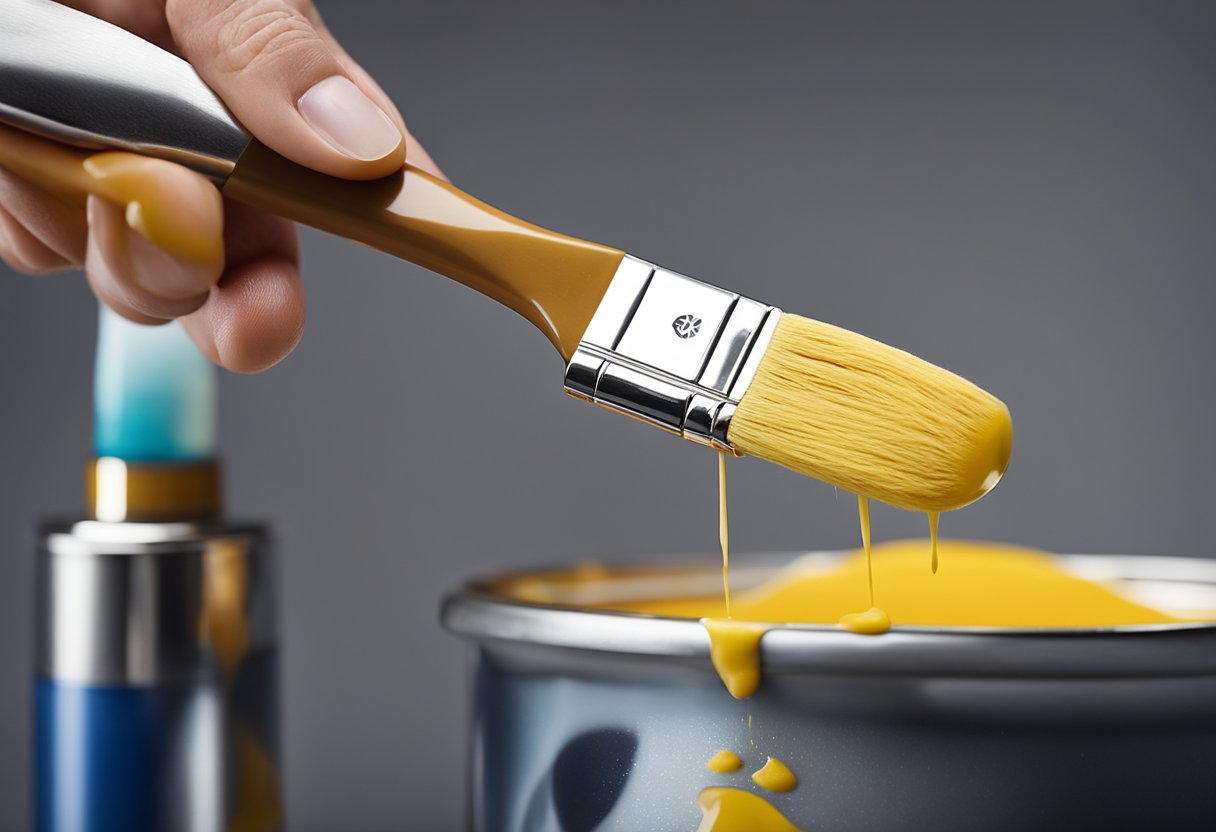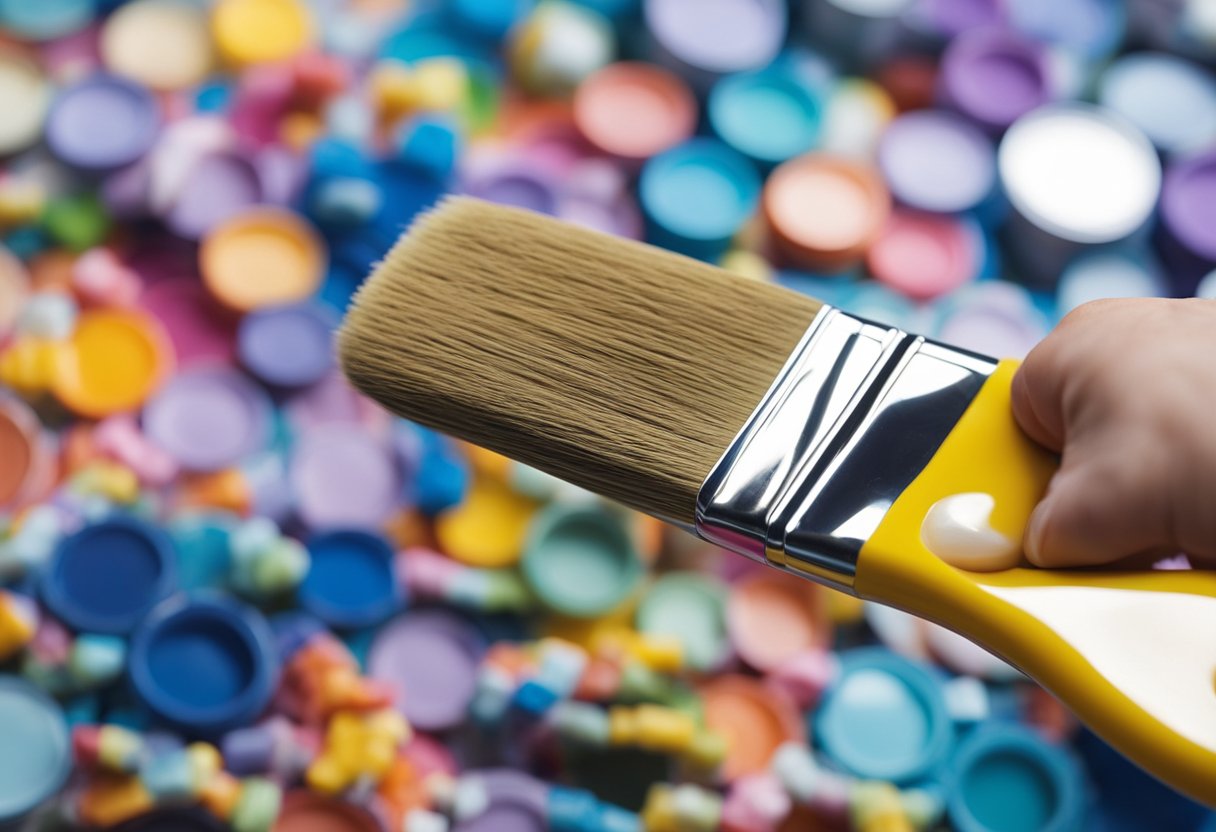Painting over silicone can be a tricky task, especially if you don’t know what you’re doing. Whether you’re trying to cover up old caulk or simply want to add a new coat of paint to your silicone surfaces, there are a few things you need to know before you begin. In this article, I’ll share some tips and tricks for painting over silicone and help you achieve a smooth, long-lasting finish.

Understanding Silicone and Its Properties is key to painting over it. Silicone is a type of sealant that is commonly used in bathrooms, kitchens, and other areas where water is present. It’s known for its flexibility and durability, which makes it a popular choice for sealing gaps and cracks. However, these same properties that make silicone so effective as a sealant can also make it difficult to paint over. Because silicone is non-porous and water-resistant, paint has a hard time adhering to its surface.
Preparation Before Painting is essential when it comes to painting over silicone. Before you even think about picking up a paintbrush, you’ll need to properly prepare the surface. This includes cleaning the area thoroughly, removing any old caulk or sealant, and roughing up the surface with sandpaper or denatured alcohol. By taking the time to properly prepare the surface, you’ll ensure that the paint adheres properly and lasts for years to come.
Key Takeaways
- Understanding the properties of silicone is crucial to painting over it.
- Proper preparation is key to achieving a long-lasting finish.
- Using the right primer and paint can make all the difference in achieving a smooth, even coat.
Understanding Silicone and Its Properties

As a painter, it is important to understand the properties of silicone before attempting to paint over it. Silicone is a flexible and waterproof material that is commonly used in construction, particularly for sealing and bonding purposes. It is also used in many household items, such as kitchenware, electronics, and personal care products.
One of the key properties of silicone is its flexibility. This means that it can expand and contract without cracking or breaking, making it ideal for use in areas that experience movement or vibration. Another important property of silicone is its waterproofness. It is resistant to water and other liquids, making it ideal for use in areas that are exposed to moisture.
When it comes to painting over silicone, these properties can pose a challenge. Because silicone is flexible, it can be difficult for paint to adhere to its surface. Additionally, because it is waterproof, it can be difficult for paint to penetrate its surface.
To overcome these challenges, it is important to properly prepare the silicone surface before painting. This may involve cleaning the surface thoroughly, sanding it to roughen its texture, and applying a primer to help the paint adhere. It is also important to use a paint that is specifically formulated for use on silicone surfaces.
By understanding the properties of silicone and taking the proper steps to prepare the surface, it is possible to successfully paint over silicone and achieve a long-lasting, professional-looking finish.
Preparation Before Painting
Before starting to paint over silicone, it is essential to prepare the surface properly. In this section, I will cover the necessary steps to ensure that the paint will adhere correctly to the silicone sealant. The preparation process involves choosing the right materials, surface cleaning and preparation, and addressing cracks and gaps.
Choosing the Right Materials
Choosing the right materials is crucial for a successful paint job. When selecting caulk, it is essential to choose a paintable caulk. The best options are silicone caulk, paintable silicone caulk, or siliconized acrylic latex caulk. It is important to note that not all silicone caulks are paintable, so it is essential to check the label before purchasing.
When selecting a primer, it is important to choose a primer that is compatible with the caulk and the paint. For example, if you are using oil-based paint, use an oil-based primer. Alternatively, if you are using latex paint, use an acrylic latex primer.
Surface Cleaning and Preparation
Before painting over silicone, it is important to clean the surface thoroughly. Begin by wiping the surface with a clean, damp cloth to remove any dirt or debris. Next, use denatured alcohol or rubbing alcohol to clean the surface thoroughly. This will help to roughen up the surface of the silicone and ensure that the paint adheres correctly.
Sanding the caulk is also an essential step in surface preparation. Use sandpaper to roughen up the surface of the caulk. This will help the paint adhere to the surface better.
Addressing Cracks and Gaps
Addressing cracks and gaps is an essential step in preparing the surface for painting. Use a caulking gun to fill any gaps or cracks in the silicone sealant. Use a putty knife to smooth out the caulk and ensure that it adheres correctly to the surface.
In conclusion, proper preparation is essential when painting over silicone. Choosing the right materials, surface cleaning and preparation, and addressing cracks and gaps are all important steps in ensuring a successful paint job.
Painting Over Silicone Caulk
When it comes to painting over silicone caulk, there are a few things to keep in mind to ensure that the paint adheres properly and looks great. In this section, I will cover the application of primer and paint.
Application of Primer
Before you can paint over silicone caulk, it is essential to apply a primer. The primer will help the paint adhere to the silicone surface, ensuring that it does not peel or flake off over time. There are different types of primers available, including latex, oil-based, and shellac spray primer.
I recommend using a shellac spray primer for any surface. It will stick to just about anything, including silicone caulk, making it the best primer to use to cover up silicone caulk to get it ready to paint over. You can purchase a can of shellac spray primer at a home improvement center or paint shop.
To apply the primer, shake the can well and spray it on the silicone surface. Ensure that the primer covers the silicone surface completely. Wait for the primer to dry completely before applying the paint.
Application of Paint
After the primer has dried, it’s time to paint over the silicone caulk. I recommend using an oil-based paint of your choice. Avoid using latex paint as it will not cover the caulking properly.
Using a brush, paint over the caulk. Ensure that the paint covers the silicone surface completely. It’s essential to let the paint dry well before exposing your silicone caulk to water or other moisture.
If you are painting over white silicone caulk, you may need to apply two coats of paint to ensure that the color is even. Be patient and let the paint dry between coats.
In conclusion, painting over silicone caulk requires the application of primer and paint. Use a shellac spray primer for any surface, and an oil-based paint of your choice. With these tips, you can ensure that the paint adheres properly and looks great.
Post Painting Care and Maintenance

After painting over silicone, it is important to take care of your project to ensure that it lasts as long as possible. Here are some tips for post-painting care and maintenance.
Sealing and Waterproofing
To ensure that your paint job remains waterproof, it is important to seal and waterproof the area around the silicone caulking. You can use a clear silicone sealant to seal the area around the caulking. This will help to prevent water from seeping through and causing damage to your project.
Mold and Mildew Prevention
Mold and mildew can be a problem in areas where there is moisture. To prevent mold and mildew from growing in the area around the silicone caulking, it is important to keep the area clean and dry. You can use a mixture of water and bleach to clean the area around the caulking. Be sure to wear gloves and protective eyewear when working with bleach.
In addition to keeping the area clean, you can also use a mold and mildew inhibitor to prevent mold and mildew from growing. These inhibitors can be found at your local home improvement store.
By following these tips for post-painting care and maintenance, you can ensure that your project remains waterproof and free from mold and mildew.
Special Cases of Painting Over Silicone
When it comes to painting over silicone, there are some special cases you need to keep in mind. Here are some of the most common ones:
Painting on Metal and Ceramic Tile
If you are painting over silicone on metal or ceramic tile, you need to be extra careful. These surfaces are often smooth and non-porous, which means that the paint might not adhere properly. To ensure that the paint sticks, you need to use a primer that is specifically designed for metal or ceramic tile.
Before you start painting, clean the surface thoroughly with soap and water. Then, apply the primer according to the manufacturer’s instructions. Once the primer is dry, you can apply the paint.
Remodel and Large Scale Projects
If you are working on a remodel or large-scale project, you might need to paint over a lot of silicone. In this case, it is best to buy your supplies in bulk. Home improvement stores often offer discounts for bulk purchases, so take advantage of this.
When buying your supplies, make sure to get enough primer and paint to cover all the silicone. It is better to have too much than too little. Also, make sure to buy high-quality supplies. This will ensure that the paint job lasts for a long time.
In conclusion, painting over silicone can be a tricky process, but it is not impossible. By following these tips, you can ensure that your paint job looks great and lasts for a long time.
Conclusion
In conclusion, painting over silicone requires proper preparation and the right products. It is possible to paint over silicone with the right techniques and products.
One of the most important steps in painting over silicone is to clean the surface thoroughly. Use a degreaser or rubbing alcohol to remove any dirt, dust, or grease. You can also use sandpaper to rough up the surface and create a better bond for the paint.
After cleaning the surface, apply a primer specifically designed for silicone. This will help the paint adhere to the silicone and prevent it from peeling or cracking. Be sure to follow the manufacturer’s instructions when applying the primer and allow it to dry completely before painting.
When it comes to choosing the paint, opt for a high-quality acrylic or latex paint. These types of paint are flexible and can withstand the movement of the silicone. Apply the paint in thin, even coats, and allow each coat to dry completely before applying the next one.
Overall, painting over silicone can be a tricky process, but with the right preparation and products, it can be done successfully. Remember to take your time and follow the manufacturer’s instructions for the best results.
Frequently Asked Questions

Can you paint over caulk?
Yes, you can paint over caulk. However, it is important to use a paintable caulk that is specifically designed for painting. Not all types of caulk are paintable, so make sure you choose a paintable caulk for this purpose.
What kind of paint will stick to silicone?
Silicone is a non-porous material, which can make it difficult for paint to adhere to it. However, there are special types of paint that are designed to stick to silicone. These include 100% silicone-based paints, epoxy paints, and urethane paints. It is important to choose the right type of paint for your project to ensure that it adheres properly and lasts a long time.
Can you put paintable caulk over silicone?
Yes, you can put paintable caulk over silicone. This is a good option if you want to change the color of your silicone sealant or if you want to cover up any imperfections. However, it is important to make sure that the silicone is clean and dry before applying the paintable caulk.
How do you paint non paintable silicone?
If you have non-paintable silicone, you can still paint over it by using a special primer that is designed to adhere to non-porous surfaces. One option is to use a shellac-based primer, which will stick to just about anything. You can also use a primer that is specifically designed for silicone surfaces.
What can you use to paint over silicone?
There are several options for painting over silicone, including 100% silicone-based paints, epoxy paints, and urethane paints. It is important to choose the right type of paint for your project to ensure that it adheres properly and lasts a long time. You can also use a special primer that is designed to adhere to non-porous surfaces before painting.
Does acrylic paint work on silicone?
Acrylic paint is not recommended for use on silicone surfaces. This is because acrylic paint is water-based, and it will not adhere properly to the non-porous surface of the silicone. It is important to use a paint that is specifically designed for use on silicone surfaces, such as 100% silicone-based paints, epoxy paints, or urethane paints.

Hi, I’m Sal Muller of Tooltrip.com. My DIY experience led me to understand essential power tools for home projects. Tooltrip.com guides enthusiasts and professionals in choosing right tools for any job. I provide concise top tool reviews for easier, efficient DIY.

